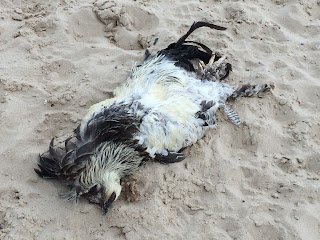October was as usual a very exciting month on the reserve at Holkham. As
well as the much publicised beaching of a dead Fin Whale, almost continuous
easterly winds brought a multitude of rare and unusual migrant birds, many from
as far away as Siberia and central Asia. Foremost amongst them were a
couple of rare wheatears. Wheatears are insect eating birds that resemble small
thrushes recognisable by having a very distinctive white rump patch and a black
and white tail. Only one species is found commonly in Britain, the
Northern Wheatear. It breeds in upland moors and mountains and occasionally on
coastal dunes. Here at Holkham it passes through in spring and autumn between
wintering grounds in Africa and breeding grounds in northern Britain,
Scandinavia and even as far north as Greenland. Its love of arable fields on
migration gave it an apt and widely used old name in Norfolk; the ‘clod hopper’.
Desert Wheatear
The two rarities, the Desert and the Isabelline Wheatear both arrived on
the same day to the same part of the reserve. Both were also of a similar sandy
brown colour. Desert Wheatears as their name suggests inhabit deserts with a
range that takes in North Africa, the Middle East and throughout the steppes
and deserts of central Asia. In Britain a handful arrive each
year in October/November usually at coastal sites along the east coast. This
year’s bird was a female (lacking the male’s black throat) and it eked out a
five day stay grubbing out insects from the sparse vegetation and beach edge
close to Gun Hill, a site that could be described as superficially being rather
desert-like in appearance! Slightly larger and with a different tail pattern
was the Isabelline Wheatear. Miraculously it remained until November 12th,
the mild conditions of late enabling it to still find plenty of insect food. It
breeds no nearer than Bulgaria and Greece in steppe-like fields, plains and
semi-desert areas right across Asia to Mongolia and China and usually winters
in the Middle East, sub-Saharan Africa and NW India. Despite its rather insipid
appearance it is famed for having a fantastic voice, its song being a loud and
rich tapestry of sounds ranging from clicks and squeaks to melodious ‘wolf
whistles’ amidst much mimicry. In Britain it remains a bona fide rarity
with only one or two every couple of years. Despite being only the
fourth Norfolk occurrence it is actually the second individual to
have been seen here on the reserve.

Isabelline Wheatear at Gun Hill.
Shore Larks basking in the
morning sun.
One other species that looks set to winter is the Shore Lark. This
delightful song bird with neat yellow and black face markings migrates to
eastern England to escape the hostilities of a winter on the high
tops of Scandinavian mountains where it nests. Varying numbers appear each year
but this winter looks like it will be a bumper season with close on 80 birds
being present already. These restless little birds favour the tide line or
areas of pioneering salt marsh where the seeds from plants such as Annual sea
blite, Samphire, Prickly Saltwort, Sea Aster and Sea Lavender are sought after
for food. The area between Holkham and Wells is typically favoured. The flock
can easily be found and at times can be most confiding. The best technique is
to find a quiet spot and wait and very often the birds may come quite close.
Please give them some space. Feeding time and a lack of disturbance is an
essential requirement for them in the short winter days so help them on their
way by keeping dogs under closer control in this area and photographers by not
venturing too close particularly if there are others trying to watch them from
further away.
Andy Bloomfield
Warden,

































